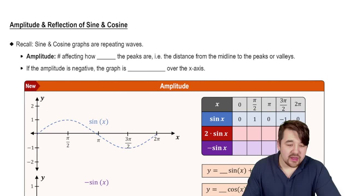Here are the essential concepts you must grasp in order to answer the question correctly.
Amplitude
Amplitude refers to the maximum distance a wave or periodic function reaches from its central axis. In the context of sine functions, it is the absolute value of the coefficient in front of the sine term. For the function y = -3 sin x, the amplitude is 3, indicating that the graph oscillates 3 units above and below the horizontal axis.
Recommended video:
Amplitude and Reflection of Sine and Cosine
Graphing Trigonometric Functions
Graphing trigonometric functions involves plotting the values of the function over a specified interval. For sine functions, the graph typically oscillates between its maximum and minimum values, determined by the amplitude and vertical shift. In this case, y = -3 sin x will have its peaks at -3 and troughs at 0, creating a wave pattern that is inverted due to the negative sign.
Recommended video:
Introduction to Trigonometric Functions
Period of Sine Function
The period of a sine function is the length of one complete cycle of the wave. For the standard sine function, the period is 2π, meaning it repeats every 2π units along the x-axis. In the case of y = -3 sin x, the period remains 2π, allowing for consistent comparison with the standard sine function y = sin x over the interval 0 ≤ x ≤ 2π.
Recommended video:
Period of Sine and Cosine Functions
 Blitzer 3rd Edition
Blitzer 3rd Edition Ch. 2 - Graphs of the Trigonometric Functions; Inverse Trigonometric Functions
Ch. 2 - Graphs of the Trigonometric Functions; Inverse Trigonometric Functions Problem 5
Problem 5 Verified step by step guidance
Verified step by step guidance


